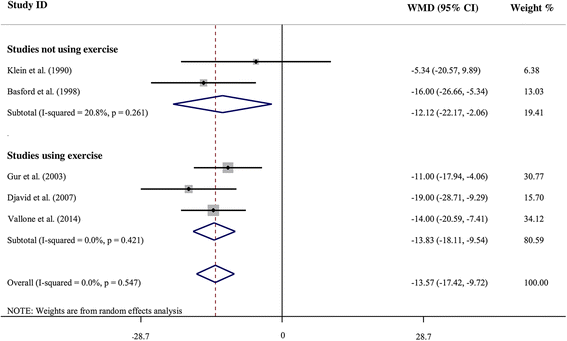The effectiveness of low-level laser therapy for nonspecific chronic low back pain: a systematic review and meta-analysis
- PMID: 26667480
- PMCID: PMC4704537
- DOI: 10.1186/s13075-015-0882-0
The effectiveness of low-level laser therapy for nonspecific chronic low back pain: a systematic review and meta-analysis
Abstract
Background: In recent decades, low-level laser therapy (LLLT) has been widely used to relieve pain caused by different musculoskeletal disorders. Though widely used, its reported therapeutic outcomes are varied and conflicting. Results similarly conflict regarding its usage in patients with nonspecific chronic low back pain (NSCLBP). This study investigated the efficacy of low-level laser therapy (LLLT) for the treatment of NSCLBP by a systematic literature search with meta-analyses on selected studies.
Method: MEDLINE, EMBASE, ISI Web of Science and Cochrane Library were systematically searched from January 2000 to November 2014. Included studies were randomized controlled trials (RCTs) written in English that compared LLLT with placebo treatment in NSCLBP patients. The efficacy effect size was estimated by the weighted mean difference (WMD). Standard random-effects meta-analysis was used, and inconsistency was evaluated by the I-squared index (I(2)).
Results: Of 221 studies, seven RCTs (one triple-blind, four double-blind, one single-blind, one not mentioning blinding, totaling 394 patients) met the criteria for inclusion. Based on five studies, the WMD in visual analog scale (VAS) pain outcome score after treatment was significantly lower in the LLLT group compared with placebo (WMD = -13.57 [95 % CI = -17.42, -9.72], I(2) = 0 %). No significant treatment effect was identified for disability scores or spinal range of motion outcomes.
Conclusions: Our findings indicate that LLLT is an effective method for relieving pain in NSCLBP patients. However, there is still a lack of evidence supporting its effect on function.
Figures



References
-
- Murray CJ, Vos T, Lozano R, Naghavi M, Flaxman AD, Michaud C, et al. Disability-adjusted life years (DALYs) for 291 diseases and injuries in 21 regions, 1990-2010: a systematic analysis for the Global Burden of Disease Study 2010. Lancet. 2012;380:2197–223. doi: 10.1016/S0140-6736(12)61689-4. - DOI - PubMed
Publication types
MeSH terms
Grants and funding
LinkOut - more resources
Full Text Sources
Other Literature Sources
Miscellaneous

